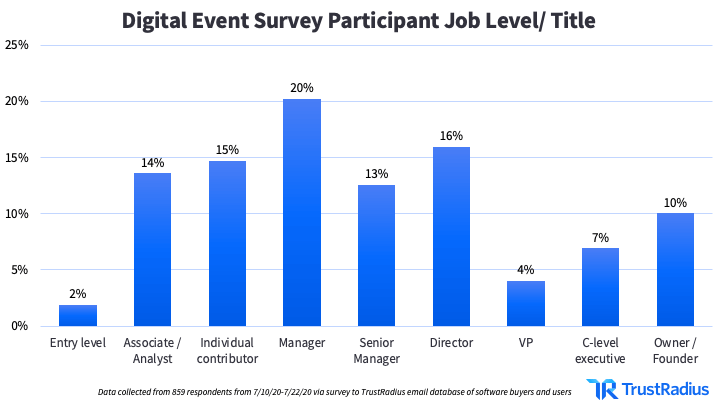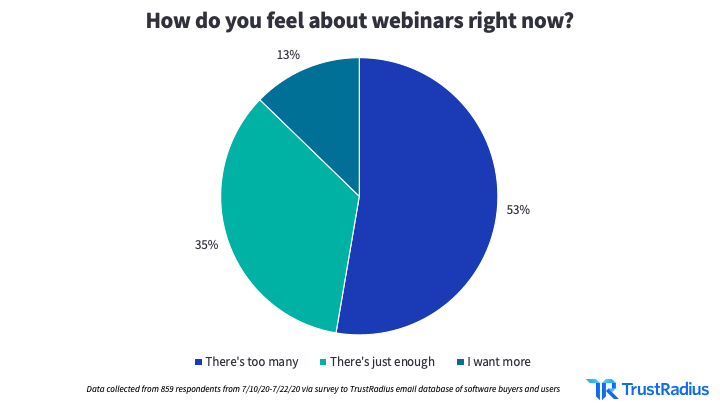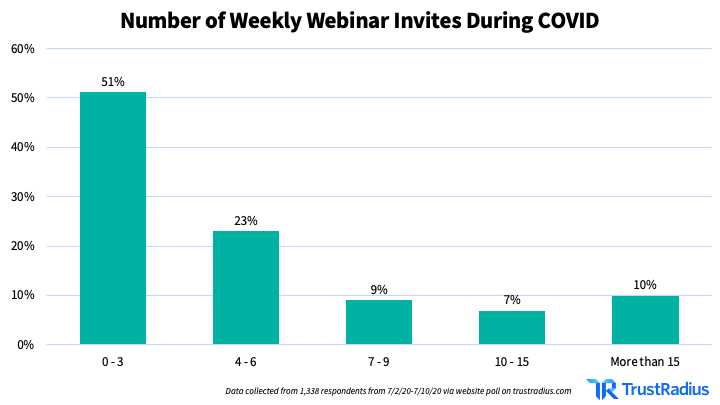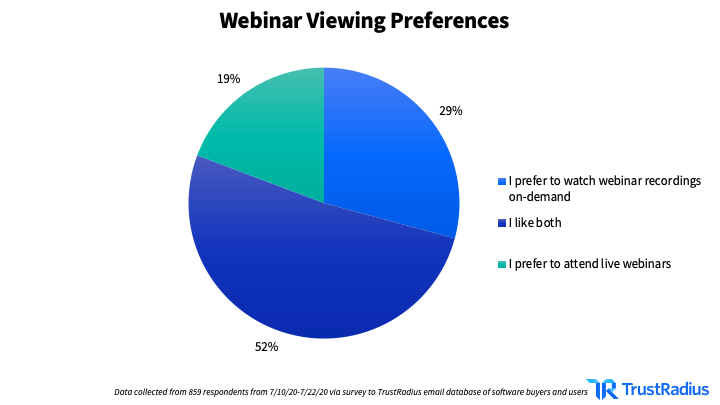The Impact of COVID-19 On Digital Events
Since the onset of the pandemic, the events industry went from a thriving $1.07 Trillion global industry to obsolete almost overnight. Tech marketers depended on the repeatable and predictable source of leads and business that events provided. The industry had to pivot but didn’t have access to benchmarks and data that fit the new business environment.
Now that the dust has settled and the transition to digital events is well underway—what are the new benchmarks and stats tech marketers can rely on? How are buyers and vendors responding to digital events?
At TrustRadius we set out to leverage our community of tech buyers and vendors to better understand user preferences and experiences around digital events. We presented that data in a digital event with some awesome partners that you can watch here, or keep reading to get the in-depth details and analysis.
When we surveyed our audience of 2,000 business professionals about digital events, we asked questions around these key topics:
- The “Who” Behind the Data
- The Industry’s REAL Feelings About Digital Events
- Why Your Inbox is Full of Invites
- Why People Attend Events
- What People Want to Experience at Digital Events
Here’s what we found.
The “Who” Behind the Data
Survey demographics
We surveyed over 2,000 tech buyers and vendors. Of that group, about 1 in 5 were event marketers.
The survey group included business professionals from all company sizes and roles, with a fairly even split between SMB (36% with 1-50 employees), Mid-size (31% with 51-500 employees), and enterprise (32% with 500—100K+), and job titles that covered the entire spectrum.
This mix of respondents is a good representation of perspectives based on the wide range of titles and organization sizes.
The Industry’s REAL Feelings About Digital Events
Digital Events fatigue is real.
When we asked ‘How do you feel about webinars right now?’ 53% of respondents felt there are too many. During the COVID-19 pandemic, the number of people who receive 7- 9 webinar invites weekly increased by 80%.
Now that majority of people are working from home (or living at work), the flow of information from all sources, professional, and otherwise has grown exponentially. In a recent article for Forbes, sociologist Tracey Brower does a great job of breaking down the reality of digital fatigue:
“In addition to the information you’re actively seeking about the coronavirus and COVID-19, you’re also flooded with more unsolicited information than ever. Businesses are reaching out to tell you about their responses. Your company is sending you regular emails to support you. You’re getting regular updates from your leadership to keep you focused and you’re receiving more solicitations than ever from consultants who are trying to survive. The deluge of information has increased and you’re trying to cope.”
Tracy Brower. “Why Working From Home Is So Exhausting—And How To Reinvigorate.” Forbes.com. Accessed 10 August, 2020.
Balancing the surge of new information and the opportunities available to learn new skills is something that many of us are struggling to get right. One surefire way to ensure that your message is being heard is to provide concise, targeted messaging to the right audiences.
Why Your Inbox is Full of Invites
Surprise surprise, people are getting more invites during COVID.
Pre-COVID-19, most people (78%) were getting 0-3 invites per week. Now, 49% are receiving more than 4. Further, the data shows that 17% are receiving over 10 weekly invites (up from 5% pre-COVID). In other words, 1 in 6 people now receive over 10 webinar invites each week—that’s a lot for any inbox.
People receive 5X more invites compared to the number of events they attend.
With people receiving so many digital event invites, how many are they REALLY attending? The majority of people only attend 0-3 digital events per month, while they receive 5X that amount in invites.
Compared to pre-COVID data, we saw an increase in the number of invites people received across all segments. For example, people receiving 4-6 invites during COVID-19 times grew 92%.
Where are all these invites coming from?
When COVID-19 shut down the in-person events industry, most marketers made a swift transition into digital events. Webinars were the most commonly grown digital event program across the B2B world. At TrustRadius, for instance, we grew our webinar program over 160% from Q1 to Q2. We can also see this growth by looking at the industry’s interest in webinar technology. On TrustRadius, we saw this category grow by 226% from March to April as marketers were adjusting to their new normal.
When we asked Marketers how many webinars they were conducting monthly, 70% said they were hosting 1 to 5, whereas about 16% of marketers are hosting over 6 webinars a month.
This increase in digital event activity can be directly tied to the loss of pipeline and revenue from live events. According to Vox, the direct economic loss from the cancellations of more than 10 key tech events due to COVID-19 is over $1.1 billion. With jobs and revenue on the line, it makes sense that digital event activity would spike to compensate for losses.
Why People Attend Events
Why business professionals attended in-person events in a pre-COVID-19 world.
Before the pandemic, people attended in-person events for 3 main reasons:
- The topic
- Networking opportunities
- The location
Since mid-March, many of these factors (including in-person networking, the location, the food, being able to travel) have necessarily become less relevant or harder to accomplish. But the value people place on a strong, well-thought-out topic has not.
When it comes to webinar substance, an engaging topic is still key
According to Sruthi Kumar, Sr. Marketing Manager at Sendoso,
“Just because you think your content is interesting doesn’t mean your audience will.”
There lies one of the true struggles of being a marketer—balancing the story you want to tell, and the information your audience wants to hear. Digital events are no different. The #1 reason people attend (or don’t) is the topic. One of our survey respondents said it best:
“I register for everything and watch the replay. That way if they are talking fluff, I can just fast forward past it.”
According to our research, another reason 16% of people don’t register for digital events is that they “don’t want to be subscribed to more marketing emails.” With professionals already receiving 4+ webinar invites a week, getting on a new marketing list is a big commitment—and clearly a step 16% of respondents don’t want to take.
To address this challenge, one progressive approach suggests providing ungated content instead. In March, TrustRadius started gathering data around how tech companies planned to alter their spending during the pandemic. We shared this information with the world with no strings attached and promised no follow-up emails from those digital events. We tested the approach of NOT adding registrants to our marketing cadences, and had some great feedback and success. Our average registration rate increased by 30%. Even though we did not add those registrants to our marketing flow, that growth was not lost—goodwill and brand awareness are factors all brands need more of.
What’s happened to webinar attendance rates?
For a large majority of marketers (87%), webinar attendance rates have either stayed the same or have increased. When chatting with industry colleagues live in the digital event where this data was first revealed, we discovered that many organizations saw an initial spike in registrations and have recently leveled out to pre-COVID registration and attendance rates. At TrustRadius we experienced the same.
Much of this is due to the fact that at that time, people had yet to start experiencing digital fatigue and were excited about the overflow of new opportunities to learn. Since then, we’ve experimented with different types of content for different targeted audiences. Our registration rates have fluctuated, but our overall attendance rate is still strong. We’ve found that the key is to try and meet your audience with the content they need in a format they want.
What does the future of in-person events look like?
In 2017, the events industry directly impacted 10.3 million jobs globally. Clearly events are a huge part of our economic system—but when will we feel safe enough to get back to in-person events? Based on our research, 72% of people won’t feel comfortable attending in-person events again until at least 2021, and 40% won’t feel comfortable attending until at least the second half of 2021. In total, about 1 in 5 respondents wouldn’t feel comfortable attending an in-person event until at least after summer 2021.
Taking cues from other large organizations can be a great way to gauge when the public will feel safe gathering in person again. In recent reports, Google plans to keep employees working remotely until at least July 2021, whereas other industry leaders like Twitter and Square will extend remote working indefinitely.
While that is hard news to hear, marketers are an innovative bunch. We’ve seen Marketers working hard to create unique experiences for digital event attendees. For example, Courtney Smith, Sr. Field & ABM Manager a6Sense had event attendees build custom shoes from a shoemaker in Spain as part of an event—one of many innovative ways marketers are connecting attendees and creating memorable experiences.
What People Want to Experience at Digital Events
Respondents’ top 10 favorite things about the webinar/digital events experience.
Even though it feels like we’re living in a different world now after COVID-19, we’ve only been hosting digital-only events for about six months. , And based on our data about how soon people want to return to in-person events, we have at least another 6 months to go before the event industry starts to open up again. So in the meantime, we wanted to dig into attendees’ favorite parts of the digital event experience.
From our research, it’s clear that Q&A sessions, other interactive elements, and the on-demand and flexible nature of webinars were the clear winners. Making it easy for attendees to interact with and consume digitals events is the #1 takeaway from this part of the survey.
How do you like your digital events served?
The majority of respondents, 52%, prefer the flexibility of having both live and on-demand digital events. The preference for live or on-demand specifically was pretty equally split.
In their own words
When we asked participants about their favorite part of digital events, here’s what they had to say:
On Interactivity:
“I like it when it’s an interactive experience and everyone can get involved in some type of way. It makes it feel more inclusive and keeps the webinar interesting!”
“The closer to the in-person seminars they can make it the better. I hate the webinar hosts who don’t read the “room” and they get to the questions all the way at the end. The interactive elements are the best. We have the technology, it’s a matter of getting everyone used to it and rocking it!”
“Interactivity of any kind is good because I need to pay attention to participate. So many things are going on, it is easy to put on a webinar, if there is only a speaker, then you can miss things due to distraction.”
On Flexibility & Accessibility:
“I like that you get the option to be live or tune in later. I like that it offers a safe, germ-free environment during the COVID-19 pandemic.”
“Being able to attend in my comfies.”
“Being able to attend more [digital events] because of the cost. If I go in person, I might only get to go to one because of travel costs.”
“I love that so many more events are possible for me to attend because I can tune in from home. I also like small group discussions on zoom sessions.”
“I can stay at home!”
Key Takeaways
A majority (72%) of people won’t feel comfortable returning to in-person events until at least 2021.
Based on our research the key takeaways we’ve found are:
Attendees feel overwhelmed by invites and are experiencing digital fatigue.
Our research shows that attendees receive 5x more digital invites than the events they attend. In 2020 we’re all experiencing digital fatigue on a greater level than ever before. Forbes recently published an article by Sara Larsen, CMO at Brightcove, discussing ways to combat digital event fatigue:
“To avoid becoming just another online event, organizations need to stay ahead of the fatigue curve. This means breaking out of comfort zones and offering more than just someone talking in front of a screen.”
Sara Larsen. “Staying Ahead Of The Curve To Avoid Online Event Fatigue.” Forbes.com. Accessed 10 August, 2020.
It’s worth exploring to find the best ways for your organization to take digital event fatigue head-on.
Attendees are very selective with events they actually attend or watch on-demand, so make your content and digital event format targeted and interesting.
When discussing the data with other industry experts, we discovered it’s not only the content but also the “venue” that can make or break a digital event. Keely O’Neill, Demand Generation Manager at Splash, said it best:
“In-person events are not one-size-fits-all, and that is even truer for virtual events — especially during a pandemic. There’s a lot of conversation about what makes virtual events stand out, but it’s more important to meet attendees where they are.”
Selecting the right topic and the right event type is crucial for connecting with your audience in a successful way.
Creating an interactive experience is key—finding ways to engage with your audience and connect attendees will make your events more successful.
Creating new ways to interact with users during a pandemic is a daunting task. However, Sruthi Kumar, Sr. Marketing Manager at Sendoso, has curated a great list of ways to bring back the in-person feel to digital experiences. Small changes can make a big difference when creating connections with your audience.
Our goal with this data and analysis is to arm marketers with insights that will help when optimizing for success when planning digital events. Want to learn more? Check out our on-demand conversation with industry experts on what this data means to them.




















